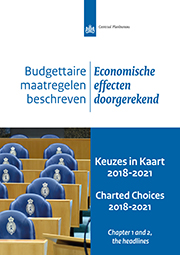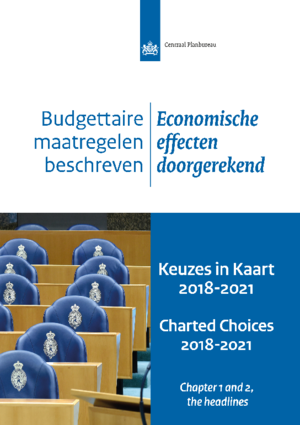Charted Choices 2018-2021
Charted Choices 2018–2021: major differences between parties

The political parties participating in this assessment are VVD, PvdA, SP, CDA, D66, ChristenUnie, GroenLinks, SGP, DENK, VNL and the Vrijzinnige Partij. Over the past months, they have submitted their election manifestos to CPB for assessment. The assessment report presents figures, per party, on the effects of the various proposed measures on Dutch economic development, as well as medium- and long-term changes in areas such as employment, purchasing power and public finances.
The differences between participating parties, from a financial-economic perspective, are presented in a series of infographics. CPB Director Laura van Geest concludes that there are considerable differences between parties: ‘There is really something to choose from. In 2012, the elections were dominated by proposed spending cuts, whereas, this time, the economy is doing much better and parties are therefore opting to increase expenditures. Each party does so by setting their own priorities, with great differences between the envisaged measures. This naturally leads to varying economic results. Choices you make today may have a stronger effect on the long-term. In particular, with respect to long-term indicators such as structural employment, long term income distribution and the sustainability of public finances, differences are greater than in previous elections.’
Choices and compromises
For this edition of Charted Choices (Keuzes in Kaart), the 9th since the start of this publication series in 1986, a total of 1,165 measures were assessed. Each measure and choice has both advantages and disadvantages. Beginning with the choice between allocating either less or more money to, for instance, health care, education, defence and public administration, versus raising or lowering taxes. Often, there are also compromises to be made; measures with an assessed favourable impact in one area, usually, have the opposite effect on other objectives. For example, economic growth may be stimulated through increased spending, but this will have a negative effect on the EMU balance and the sustainability of public finances, in the long term. And a positive impact on employment is generally accompanied by an increase in income inequality.
Societal debate
Participation in the ‘Charted Choices’ assessment is voluntary. All parties in possession of at least one seat in the Dutch House of Representatives in mid October 2016 were invited by CPB to have their election manifestos assessed. Of those parties, 11 responded to this call, which is one more party than at the time of the previous elections. During the calculations to determine their economic impact, the election manifestos were compared against the baseline situation as presented in CPB’s most recent medium-term projections (2018-2021), which were published on Prinsjesdag (the day of the King’s speech) 2016, in the Macro Economic Outlook (MEV). In this way, insight could be provided into the economic effects of the choices made and priorities set by the various parties. And, although politics is about more than mere facts, measures and the economy, Charted Choices is aimed to contribute to these aspects of societal debate. In doing so, CPB refrains from making value judgements or from giving advice, and therefore appoints neither winners nor losers.
Online publication, book and data visualisation
The assessment of the election manifestos is available as a convenient online webpublication (in Dutch), which includes explanations and references, and as a digital book (pdf). In addition, there is an interactive data visualisation (in Dutch), providing insight into the differences between the political parties.
Note to the editor:
For more information, please contact the following CPB experts:
| Onderwerp | Contactpersoon | Telefoon |
| General information & interview requests | Suzanne van Gils | +31 (0)621560776 |
| Project leader Charted Choices (Keuzes in Kaart) | Johannes Hers | +31 (0)646035142 |
| Budget, EMU balance and public debt | Wim Suyker | +31 (0)652485860 |
| Health care | Rob Aalbers | +31 (0)621704716 |
| Macroeconomic impact | Debby Lanser | +31 (0)629419089 |
| Purchasing power | Rob Euwals | +31 (0)655736513 |
| Long-term policy effects on income and distribution of income | Patrick Koot | +31 (0)646360575 |
| Structural employment effects | Marloes de Graaf-Zijl | +31 (0)646801306 |
| Sustainability of public finances and pensions | Marcel Lever | +31 (0)652485856 |
Downloads
The political parties participating in this assessment are VVD, PvdA, SP, CDA, D66, ChristenUnie, GroenLinks, SGP, DENK, VNL and the Vrijzinnige Partij. Over the past months, they have submitted their election manifestos to CPB for assessment. The assessment report presents figures, per party, on the effects of the various proposed measures on Dutch economic development, as well as medium- and long-term changes in areas such as employment, purchasing power and public finances.
The differences between participating parties, from a financial-economic perspective, are presented in a series of infographics. CPB Director Laura van Geest concludes that there are considerable differences between parties: ‘There is really something to choose from. In 2012, the elections were dominated by proposed spending cuts, whereas, this time, the economy is doing much better and parties are therefore opting to increase expenditures. Each party does so by setting their own priorities, with great differences between the envisaged measures. This naturally leads to varying economic results. Choices you make today may have a stronger effect on the long-term. In particular, with respect to long-term indicators such as structural employment, long term income distribution and the sustainability of public finances, differences are greater than in previous elections.’
Choices and compromises
For this edition of Charted Choices (Keuzes in Kaart), the 9th since the start of this publication series in 1986, a total of 1,165 measures were assessed. Each measure and choice has both advantages and disadvantages. Beginning with the choice between allocating either less or more money to, for instance, health care, education, defence and public administration, versus raising or lowering taxes. Often, there are also compromises to be made; measures with an assessed favourable impact in one area, usually, have the opposite effect on other objectives. For example, economic growth may be stimulated through increased spending, but this will have a negative effect on the EMU balance and the sustainability of public finances, in the long term. And a positive impact on employment is generally accompanied by an increase in income inequality.
Societal debate
Participation in the ‘Charted Choices’ assessment is voluntary. All parties in possession of at least one seat in the Dutch House of Representatives in mid October 2016 were invited by CPB to have their election manifestos assessed. Of those parties, 11 responded to this call, which is one more party than at the time of the previous elections. During the calculations to determine their economic impact, the election manifestos were compared against the baseline situation as presented in CPB’s most recent medium-term projections (2018-2021), which were published on Prinsjesdag (the day of the King’s speech) 2016, in the Macro Economic Outlook (MEV). In this way, insight could be provided into the economic effects of the choices made and priorities set by the various parties. And, although politics is about more than mere facts, measures and the economy, Charted Choices is aimed to contribute to these aspects of societal debate. In doing so, CPB refrains from making value judgements or from giving advice, and therefore appoints neither winners nor losers.
